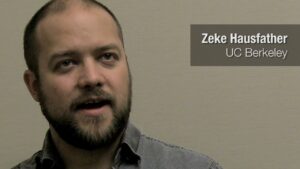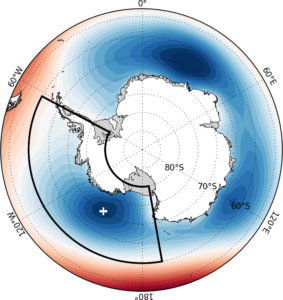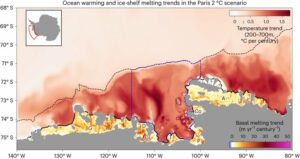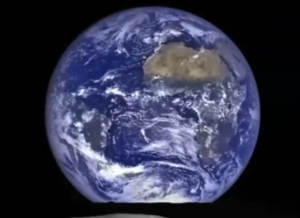Global warming is accelerating, at double the rate just a dozen years ago. The target of 1.5 degrees Celsius is “dead as a door-nail”. Earth will warm not 3 degrees, but 4.8 degrees C – 10 degrees F. – according to former NASA scientist James Hansen in his new paper “Global Warming in the Pipeline”. Press Conference Nov. 2 NYC. Then Dr. Kaitlin Naughten from the British Antarctic Survey, lead author of a new paper revealing Antarctic melting now cannot be stopped.
All this and more according to a stunning new peer-reviewed paper led by famous NASA scientist James Hansen. Other top scientists disagree. Is Hansen right this time?
Listen to or download this Radio Ecoshock show in CD Quality (57 MB) or Lo-Fi (14 MB)
“So the climate on our remarkable home planet is characterized by delayed response and amplifying feedbacks, which is a recipe to lock-in inter-generational injustice.”
– James Hansen, the former NASA super-scientist who warned the world about global warming in 1988.
Dr. James Hansen spoke about the new paper “Global Warming in the Pipeline” at a press briefing November 2nd, at Columbia University in New York City. Hosting the event was the U.N. Sustainable Development Solutions Network (SDSN) and it’s President Columbia’s Professor Jeffrey Sachs. You will hear Hansen’s presentation and answers to two questions, including Associated Press reporter Seth Borenstein. Seth consulted other top climate scientists who dispute the extreme future painted by Hansen and his 16 co-authors. My comments follow.
During his presentation, Hansen cites worries about melting glaciers in Antarctica and high sea level rise. You will hear Dr. Kaitlin Naughten from the British Antarctic Survey, lead author of a new paper revealing Antarctic melt that now cannot be stopped.
Here is Dr. James Hansen recorded at a press presentation on the new paper “Global Warming in the Pipeline”, at Columbia University on November 2nd, 2023. You can watch the full hour-long press briefing on YouTube. The title is “An Intimate Conversation with Leading Climate Scientists To Discuss New Research on Global Warming”.
https://www.youtube.com/watch?v=NXDWpBlPCY8&t=165
Some highlights from the paper, followed by cautions
“Global Warming in the Pipeline” is a long paper, well laid out and readable. It begins with a short history of common assumptions developed by American scientists since 1965. The Intergovernmental Panel on Climate Change adopted three degrees C as the maximum expected when carbon dioxide in the atmosphere doubles pre-industrial levels. The mainstream assessment first set 2 degrees C. warming as the line we should not cross, then said 1.5 degrees warming is dangerous. The 2 degree “safe” level was set arbitrarily by economist William Nordhaus in 1975. Although adapted by the 2015 Paris Climate Agreement, there is no particular science behind this “limit”.
Hansen and his co-authors claim a better way to predict what adding carbon to the atmosphere will do. They focus not on CO2 levels, but Earth Energy Imbalance. More energy is arriving than leaving. The extra has been stored in the ocean, but that is just a delay mechanism. The heat is likely to come back into the atmosphere centuries later.
That delay, says Hansen, makes the situation more dangerous. Humans fail to see the impact of increasing planetary energy until it is too late. Now, after decades of neglect and delay, only extraordinary actions can interrupt the physics of a planetary system seeking energy balance. Even ending fossil fuel emissions would not be enough now, say Hansen and his colleagues.
————–
The new paper begins:
“Roger Revelle wrote in 1965 that we are conducting a ‘vast geophysical experiment’ by burning fossil fuels that accumulated in Earth’s crust over hundreds of millions of years.”
We unwittingly geoengineered the atmosphere, ocean, and ice systems. Now Earth is experiencing extreme consequences. Hansen and crew say we need to accept efforts to cool the planet, before major cities around the world go underwater, and weather becomes even more hostile. They make a rationale for why Earth needs human geoengineering.
An essential question: how much will Earth warm with each addition of greenhouse gases to the atmosphere? To get a better answer, this team used new science to adjust figures used for Earth Climate Sensitivity. Hansen et al. measured temperature and corresponding carbon levels at two points: the peak of the last maximum of glaciation, around 13,000 years ago, to a point in our recent time, the Holocene, around 7,000 years ago. That is when sea level as we know it more or less stabilized, indicating a planet in balanced energy.
But then, Hansen’s group says something changed from the great cycle of cooling and warming seen over ages. Here is a quote from the paper:
“The Holocene is an unusual interglacial. Maximum melt rate was at 13.2 [thousand years before the present] kyBP, as expected, and [Greenhouse Gas ] GHG amounts began to decline after peaking early in the Holocene, as in most interglacials. However, several [thousand years] ky later, [carbon dioxide] CO2 and [methane] CH4 increased, raising a question of whether humans were affecting [Greenhouse Gases] GHGs. Ruddiman suggests that deforestation began to affect CO2 6500 years ago and rice irrigation began to affect [methane] CH4 5,000 years ago.”
Human induced climate changes may have begun thousands of years ago. Then we found the hidden accelerator in coal, oil, and gas. Now scientists say we created a new age where humans determine climate – the Anthropocene.
A number of current NASA scientists are co-authors of the paper, presenting satellite data on the imbalance of planetary energy. Also at this press conference, Leon Simons, the Dutch Club of Rome member who identified changes in ship emissions with a speed-up of warming, the kind we are living through now. That is explained in detail in my interview with Leon, January 11, 2023. You can listen to that free at ecoshock.org.
WAITING FOR THE UGLY TRUTH TO SET IN?
If Hansen and colleagues are right, mainstream science as represented by the Intergovernmental Panel on Climate Change, and discussed at the annual COP climate conferences, seriously underestimates developing warming, melting, and rising seas. None of the actions Hansen finds essential to save us are happening.
In his book “Storms of My Grandchildren”, and in this press briefing, James Hansen warns we are wrecking the future for our descendants. He understands humanity will take more years to accept the verdict of planetary reality, but hopes during that time young people will experience the reality – and find ways to cool the planet.
OTHER SCIENTISTS DISAGREE WITH THIS BLEAK ASSESSMENT
Other top scientists publicly disagree with the results of this paper. From Penn State, the inventor of the hockey stick graph of warming, Dr. Michael Mann says “the truth is bad enough” without what he sees as alarming exaggeration. In a blog post on this paper, Mann adds: “There is no evidence that changes in ship-based aerosols have played any substantial role at all in recent warming trends.” Mann has a series of criticisms and disagreements with Hansen’s paper.


Scientist Zeke Hausfather also disagreed with these high estimates of warming in the pipeline. I checked with some of my scientific guests on Radio Ecoshock. In private correspondence they said Hansen has been a loner in the scientific community and now edges on cult status rather than consensus. I am not expert enough to judge. I expect a lot more assessment of this paper.
Meanwhile, everyone has to admit 2023 revealed truly alarming climate impacts: flash-floods around the world, wildfires changing the atmosphere, and heat, heat, heat like no one has ever seen. Not to mention the hurricane that blew up out of nowhere and wrecked Acapulco, storms battering Europe, – too much, too strange to list.
James Hansen says expect even more of all that. You ain’t seen nothing yet. As this decade develops, we will find out.
In this press presentation Hansen three times pointed to the risk of Antarctic glaciers melting, raising sea levels around the world. James Hansen has promised a sequel paper about rising seas in the pipeline. When asked his assessment of the most important approaching tipping point, Hansen pointed to glaciers in West Antarctica, and specifically around the Amundsen Sea. We are fortunate to have the lead author of a new study finding that pipeline also includes rising seas.
Here we go.
====================================
KAITLIN NAUGHTEN – BRITISH ANTARCTIC SURVEY:
MORE ANTARCTIC MELT AND SEA LEVEL RISE UNSTOPPABLE
“It looks like we’ve lost control of melting of the West Antarctic Ice Sheet. If we wanted to preserve it in its historical state, we would have needed action on climate change decades ago. The bright side is that by recognising this situation in advance, the world will have more time to adapt to the sea level rise that’s coming. If you need to abandon or substantially re-engineer a coastal region, having 50 years lead time is going to make all the difference.”

Dr. Kaitlin Naughten, British Antarctic Survey
That is Dr Kaitlin Naughten, researcher for the British Antarctic Survey and lead author of the new paper “Unavoidable future increase in West Antarctic ice-shelf melting over the twenty-first century”. It was published October 23rd in the journal Nature Climate Change. This is Open Access (free) but a complicated study of invisible ocean currents flowing in dark waters underneath very thick glaciers floating in the Polar sea. The findings will impact coastlines all over the world.
Listen to or download my 23 minute interview with Kaitlin Naughten in CD Quality or Lo-Fi
ROBOTS HAVE A LOOK
We have breaking science from Peter Washam and colleagues, published October 27 in Science Advances, about their direct observations below ice shelves in the Amundsen Basin. Their work adds to the growing body of research showing significant melting at the bottom of big ice shelves along the West Antarctic Peninsula. The title is: “Direct observations of melting, freezing, and ocean circulation in an ice shelf basal crevasse.”
Just to be clear, glaciers floating in the sea have already displaced their mass or weight. They do not add to sea level rise. So why the concern? Because Polar ice shelves hold back the flow of glaciers into the sea. According to the National Snow and Ice Data Center in Colorado:
“After the 2002 Larsen B Ice Shelf disintegration, nearby glaciers in the Antarctic Peninsula accelerated up to eight times their original speed over the next 18 months. Similar losses of ice tongues in Greenland have caused speed-ups of two to three times the flow rate in just one year.”
In 2014, a NASA study declared the big Thwaites Glacier was in irreversible decline. It’s progress toward the sea was “unstoppable” NASA said. Now we can add the loss of Amundsen Sea ice shelves and then mass ice loss from the mainland glaciers – resulting in meters of sea level rise (over time).
IT IS NOT HOTTER WEATHER…
Strangely, this new risk of sea level rise from Antarctica is not caused by increasing atmospheric heat at the South Pole, or any surface phenomenon, like increasing rain. This paper focuses on the intrusion of slightly warmer waters under the floating ice shelves, called the Circumpolar Deep Water. That warmer subsurface water flow can only change sea level rise under certain conditions: where it reaches under floating ice shelves. That is why Naughten’s paper says the Amundsen Sea will contribute more to near-term rising seas than other parts of Antarctica.

Kaitlin explains this in a Tweet/X:
@kaitlinnaughten
“Climate change is the cause of these simulated trends – but the main determinant of the precise amount of warming is climate variability, not the emissions scenario. The trend can vary by a factor of 2 depending on the timing of natural, unpredictable events like El Niño.”
The author say: “Even under the most ambitious mitigation scenario, Paris 1.5 °C, the Amundsen Sea warms three times faster than in the twentieth century.”
A larger and definitely natural variation is the Pacific Decadal Oscillation (PDO). Over a period of twenty to thirty years, the ocean goes in phases of mixing down warm water from the surface into deeper layers, and then allowing that warmer water to rise to the surface again.
We don’t know what causes the PDO, but scientists suggest that was behind the apparent slow-down in the rate of warming during the period from around 1999 to 2012. The planet got warmer during that period, but at a slower rate than (a) might be expected with the burst of fossil fuel emissions during that time and (b) than the period before and after it. Current scientific thinking is during the slow-down, the ocean was more vigorous in mixing down heat, absorbing the extra energy bounced back by more greenhouse gases. When that phase was over, more record heat and record heat increases re-appeared. In any case, that showed the rate of global warming has not been directly tied to the rate of emissions, as seen by Naughten et al in their study.

THE CRUX: NO GOING BACK
Now to the crux of the paper by Naughten et al. Like many studies, they worked out changes for levels of warming identified in IPCC reports: 1.5 degrees of warming, a middle-ground warming up to say 4.5 degrees C, and the very worst so-called business-as-usual RCP 8.5 degrees C. The Paris Climate Agreement assumes if humans limit warming to agreed levels, there will be less sea level rise. But that is not what this study found.
It appears we have been operating under two false assumptions: the first is that changes in atmospheric winds would be a prime driver of ice changes in Antarctica. The second assumption is the rate of heating determines the amount of ice loss. But this research found other natural cycles and events may actually set the pace of sea level rise – yes, ENSO (La Nina/El Nino) but also long term ocean cycles like the Pacific Decadal Oscillation, and maybe even accidental volcano eruptions. The emissions path forces ocean warming which melts glacier bottoms, but does not directly determine the rate of ice loss.
Dr. James Hansen and his colleagues just published a new paper about global warming in the pipeline. Now it sounds like there is also sea level rise in the pipeline. Earlier, Hansen promised another paper in his series, this time on sea level rise.
At least we know this sea level rise from Antarctica is coming. The study authors suggest humans have 50 years lead-time to adapt. That sounds like a long time, but we had 35 years since James Hansen first warned Congress of dangerous climate change and only made it worse during that time. If we get smarter, maybe we can prepare for known Antarctic sea level rise.
READ KAITLIN NAUGHTEN’S ARTICLE IN THE CONVERSATION
Increasing melting of West Antarctic ice shelves may be unavoidable – new research
Published: October 23, 2023
———————————————-
SEE ALSO:
Mouginot, J., Rignot, E. & Scheuchl, B. Sustained increase in ice discharge from the Amundsen Sea Embayment, West Antarctica, from 1973 to 2013. Geophys. Res. Lett. 41, 1576–1584 (2014).
SEE ALSO THIS NEW PAPER ON ANTARCTIC ICE
Subglacial discharge accelerates future retreat of Denman and Scott Glaciers, East Antarctica
Tyler Pelle, Jamin S. Greenbaum et al.
October 27, 2023 in Science Advances Open Access
COVERED BY CNN HERE:
A hidden feedback loop under Antarctica’s glaciers could accelerate sea level rise, scientists find
———————————————
PRESS ARTICLES TO FOLLOW UP:
British Antarctic Survey press story
A Tweet/x from American author Jeff Goodell
@jeffgoodell
We just don’t know the upper boundary for how fast [the collapse of the West Antarctic ice sheet] can happen,” scientist Richard Alley told me in 2017. “We are dealing with an event no human has ever witnessed before. We have no analogue for this.”
The Doomsday Glacier
In the farthest reaches of Antarctica, a nightmare scenario of crumbling ice – and rapidly rising seas – could spell disaster for a warming planet.
By Jeff Goodell MAY 9, 2017
West Antarctic ice sheet faces ‘unavoidable’ melting, a warning for sea level rise
By Scott Dance and Chris Mooney
October 23, 2023
ALSO THIS NEWS FROM MONGA BAY: MORE FAILURE TO PROTECT SPECIES ENDANGERED BY ICE AND CLIMATE CHANGES IN ANTARCTICA
Amid record melting, countries fail again to protect Antarctic waters
Amid record melting, countries fail again to protect Antarctic waters
by Francesco De Augustinis on 30 October 2023
===========================
That’s it for Radio Ecoshock this week. Thank you for listening, and caring about our world.
We end with a song/poem “Confessions of an Autoholic” by Alex Smith.

Not sure why James Hansen is getting so much pushback. Private opinions about his personality or “cult” status aside, at least he is willing to get the facts out for everyone to see.
The data is clear. The energy imbalance of the planet has doubled in just a few decades. Where do the other scientists think all that heat is going?
One small note, Hansen is clear that we must reduce emissions to zero FIRST, before any “planet cooling” scheme is attempted, otherwise continued emissions will easily overwhelm any geoengineering efforts.
Sadly, turning off 80 percent of our energy supply will crash 100 percent of our big, shiny civilization.
Oops!
Well said, sir.
Maybe people simply don’t understand just how much heat is going into the oceans. The world’s oceans have been sucking up 90 percent of our fuck-ups for decades. We have only just barely begun to pay those bills, and we would continue to feel that pain for decades even if we all stopped burning tomorrow.
Here’s another gut-punching feedback loop:
Warmer oceans become less mixed.
Less mixing means less heat uptake.
Read more here:
Recent acceleration in global ocean heat accumulation by mode and intermediate waters
http://www.nature.com/articles/s41467-023-42468-z
“Our work reveals accelerated warming in the upper 2000 m of the ocean over the past several decades … Exactly how this heat uptake plays out over the coming decades and beyond remains highly uncertain. For example, climate change-induced warming and freshening at the surface are projected to stratify the upper ocean, which will reduce the overturning of these water masses, in turn reducing their capacity to uptake heat. This would have profound implications for the rate of future anthropogenic climate change.”
I trust was James Hansen says over what mealy mouthed media darling Michael Mann says. Hansen is by far the more experienced and knowledgeable scientist. Hansen has been involved from the beginning and had dedicated his life to saving humanity. With multiple tipping points now cascading exponentially, it won’t be long now and we will be gone.
One thing the paper points out is that we have been geo-engineering earth beginning with wide-scale deforestation. We can reverse much of the deforestation and draw down CO2 levels by greatly reducing our consumption of animal products. We will need far less land kept tree free for crops and pasture if we eat plants directly rather than cycling them through animals, a very inefficient way to produce food for humans. This would help buy us time to gradually reduce fossil fuel pollution.